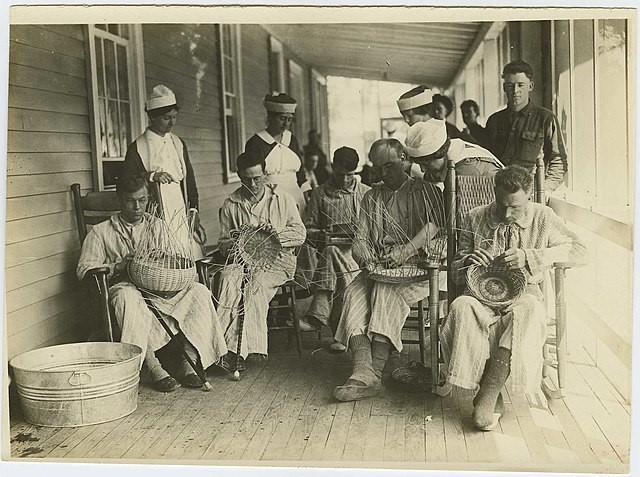How the ravages of history launched two profound professions
Published: 13 May 2023
By Christopher Schmidt, Kessler Rehabilitation Center
via the Patch Media Caldwells, NJ web site

soldiers-basket-weaving
American soldiers recovering from severe wounds in World War I learn basket weaving as a form of occupational therapy, led by the World War Reconstruction Aides Association.
World War I helped transform therapy into two separate categories
When a doctor recommends occupational therapy (OT), rather than physical therapy (PT), many people don’t at first realize there are two kinds of therapies.
It might also not be understood that there’s a difference between them, or why a doctor prescribes one over the other.
As therapists, we get this question a lot.
For sure, there’s a difference between the therapies and how they’re used in healing and recovery. And the story is more interesting than you might imagine…
A short history of modern therapy
Movement and manual therapies can be traced back to ancient Asia, Greece and Rome. Those early practices included massage and hydrotherapy (water therapy).
Fast-forward to modern-day therapy which began in 18th century Sweden with the practice of orthopedics — the medical focus on bones and muscles.
A bit later, Hanrik Ling, developed the Swedish Gymnastic System (also known as the Swedish Movement Cure). His motivation? Having experienced the benefit of improved body movement through his practice of fencing.
At its core, Ling’s system emphasized physical conditioning for its ability to improve health and body function. It combined lesser intensive floor-style of gymnastics with manual therapy. Ling’s approach brought wide acceptance of his methods.
In 1813, the Swedish government appointed Ling to start the Royal Central Institute of Gymnastics (RCIG).
Ling’s system became wider spread as graduates of the RCIG adopted its four core components:
- physical education
- fencing
- massage, physical therapy, physiotherapy
- dance performance
- One more fast-forward to the 1920s. The polio epidemic was raging in the United States, especially among children.
During the epidemic, two schools of thought emerged.
One used the practice of immobilizing the limbs of patients believing limb movement and stretching would impair muscle recovery and cause more deformity.
A second practice re-introduced the Roman practice of hydrotherapy. Here therapists used exercise in heated pools to improve a patient’s muscle recovery and movement.
Polio paralysis spurred working with patients to improve balance and regain muscle strength. The benefit of warm water was helpful as well as buoyancy – water supports body weight and reduces stress on the joints.
The practice – active polio therapy – helped grow a population of physical therapy (PT) specialists who became instrumental in treating polio paralysis.
These early PTs developed methods for assessing and strengthening muscles – methods still used today.
This piece of history gave the push to establishing the profession of physical therapy in the U.S.
Turning now to the topic of occupational therapy (OT), its history doesn’t stretch back as far as those of physical therapy.
Read the entire article on the Patch Media web site.
External Web Site Notice: This page contains information directly presented from an external source. The terms and conditions of this page may not be the same as those of this website. Click here to read the full disclaimer notice for external web sites. Thank you.



